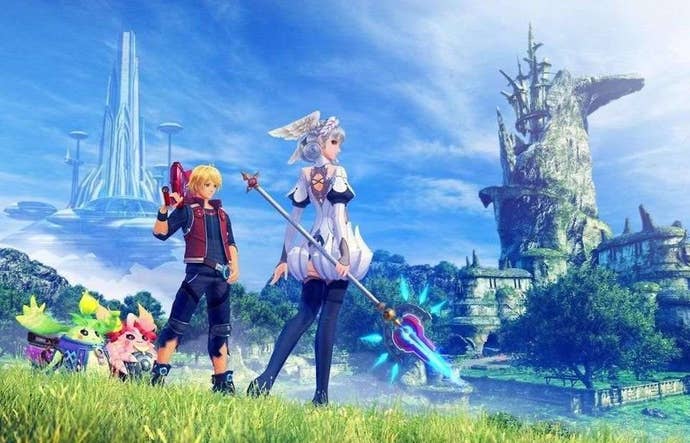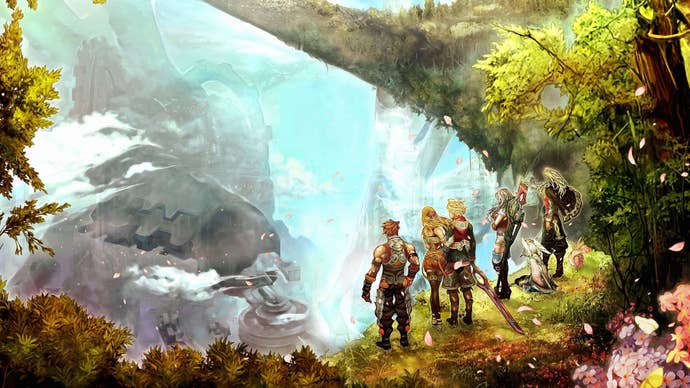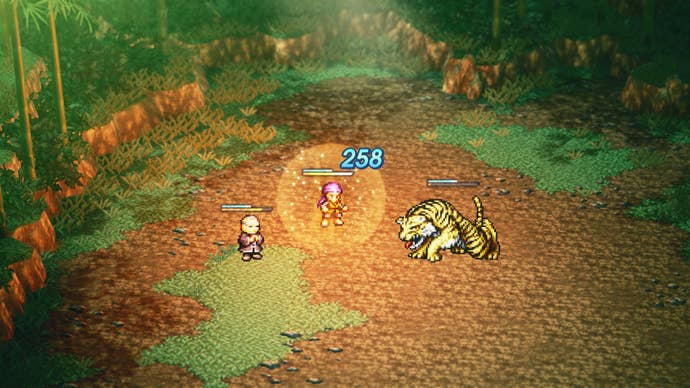Live A Live and Xenoblade 3 showcase Nintendo’s new RPG golden age
Through exclusivity deals and first party bangers, Nintendo is circling the RPG throne once again.
Over the last week, I’ve been lucky enough to find myself playing both Xenoblade Chronicles 3 and Live A Live for preview and review at the same time. While you’ll have to wait a little while longer for me to give you a review verdict on either game, playing them has awakened one specific thought: Nintendo is currently in a Japanese RPG renaissance – and it’s awesome.
It’s not like Japanese RPGs have ever stopped being brilliant. But I’d say it’s fair to suggest that there have been a couple of JRPG golden ages over the years. The original PlayStation was of course home to a legendary explosion of creativity and ambition in the Japanese RPG space, with some industry-shaking results. Immediately before that, the Super Nintendo was home to many entries in the genre that remain some of the greatest games of all time. Given they’re back-to-back, and given that most developers switched from SNES to PS1, you can view this as either one long golden age or two discrete ones, but the point is that this was always the genre’s high. They were heights I wasn’t convinced would ever be reached again. And yet… here is the Nintendo Switch.

One thing that’s different now to then is Nintendo itself. Nintendo hasn’t typically been very hot on the role-playing genre. There’s Mother (aka Earthbound), Fire Emblem, and experimentation with RPG concepts across the Zelda series, particularly in Zelda 2, but Nintendo has never been that much of an RPG devotee. All of that golden age support on the SNES came from third parties; from Square with Final Fantasy, Chrono Trigger and their kin, from Capcom with Breath of Fire, and Enix with Dragon Quest – to name a few. Notably, most of Nintendo’s own RPGs of that era also never got localized: the company never even saw the point of releasing them outside of Japan.
Legendary Nintendo boss, the late Hiroshi Yamaguchi, perhaps best encapsulated Nintendo’s attitude to RPGs. Bitterly speaking about the genre after Final Fantasy’s departure to PlayStation, the famously acerbic executive described people who play RPGs as “depressed gamers who like to sit alone in their dark rooms and play slow games.” And, well… yeah, what of it?

All of that slowly began to change over recent years, however. You can’t point to any one thing that changed Nintendo’s mind, but there are some key flashpoints. The inclusion of Marth and Roy in Smash Bros. Melee caused a surge of Western interest in the characters, which in turn led to Western releases for some Fire Emblem titles. Then there’s Monolith Soft, a developer made up of ex-Square role-playing experts. After a deterioration in the studio’s relationship with Namco, Nintendo purchased a majority stake in the developer. Monolith became a key support studio for Nintendo, helping out on titles like Animal Crossing, Zelda, and Splatoon – but it also continued doing what it did best – making RPGs.

This set the stage for where we’re at now. Eventually Fire Emblem had its watershed moment with Awakening on the 3DS – and then again, to a greater degree, with Three Houses. Monolith’s Xenoblade, at first, seemed it might have an old-school fate of not getting a full Western release – but fan pressure forced a release. That was that, then – Xenoblade, too, became a big enough deal to get several sequels.
The final piece of the puzzle, of course, is the Switch itself. A perfect device for a Japan moving away from traditional consoles to an obsession with portable devices; the best of both worlds between consoles and handhelds. While they’re big in the west, Japanese RPG developers of course think about their domestic audience first – and so many developers are flocking to Switch.
This is the story behind titles like Live A Live, Octopath Traveler, and Triangle Strategy - relatively lavish Square Enix productions that one would usually expect to be multiplatform, but instead are going Switch-first, if not entirely Switch-exclusive. Wisely, Square Enix has also given up publishing duties for these games in the West - letting Nintendo ply its particularly strong understanding of its Western market to sell these unique titles.
Live A Live, in particular, feels like an incredibly appropriate thing to release during this new ‘golden age’ of RPGs on the Switch. It’s a title from the legendary line-up of 90s SNES RPGs – but one that is lesser known. It never got a release in the West, and even in Japan it was overshadowed by Square’s other two big games at a similar time – Chrono Trigger and Final Fantasy 6.

Chrono Trigger shares much in common with Live A Live. Live A Live’s dimension and timeline-hopping story feels like a precursor to that genre best – and not just because the two projects shared many developers. Its structure feels quite timeless, and playing this remaster feels like a real classic has dropped out of a time portal. That’s true for me - a saddo who muddled his way through the Japanese original on SNES9x back in the day - and so I can’t imagine how potent that feeling will be for somebody who knows nothing about the original.
Xenoblade 3, meanwhile, is just… sort of astonishing? I felt the same way about Xenoblade 2, but what’s shocking is that this is a Nintendo game. This isn’t the sort of game that Nintendo typically makes; but Monolith Soft has carved out a niche and is now owning it, making the sort of lore-rich, criss-crossing complexity that was the purview of Square’s PS1 finest.

Xenoblade 3 is a difficult game to talk about at preview phase - there’s too much to spoil - but suffice it to say that this is very much the same sort of game as the past two Xenoblade titles. That means there’s an eye-burning onslaught of UI overlay and an absolute ton going on in battle at any given time - but as with previous games, while initially at risk of appearing overwhelming, it quickly becomes forgiven as it facilitates fast-paced, compelling combat with deceptive depth.
More interesting this time around is what this title is doing narratively. Again, I don’t want to say too much now – but after two relatively disparate titles across the first and second games (not counting the spin-off Xenoblade X), this third game seems poised to bring the worlds and characters of those two games together, alongside introducing a new cast for the third game. You’ll see familiar faces and races, or characters who look like they might have a connection to another from the past – teasing out where the story might go and what connections might be drawn between these games. It’s a lore nerd’s dream.
These two games feel opposite ends of the spectrum: an old-school, 2D classic, and a modern, 3D, full-fat RPG that’s probably too big for its own good. But these are just pieces of Nintendo’s RPG picture. We know a new numbered Fire Emblem is on the way. Spin-offs, like the recently released Warriors: Three Houses, have surprisingly dense RPG credentials – and the third-party role playing support is off the charts.
If you’re a role-playing game fan with a Nintendo console, this is the best time for you since the SNES. That’s a big deal – and Nintendo’s first-party published efforts underline the firm’s newfound commitment to the genre. I couldn’t be happier. All I need to seal the deal is a new Golden Sun. Let Camelot out of the Mario sports mines, won’t you, Nintendo? You could have a new Fire Emblem on your hands.



